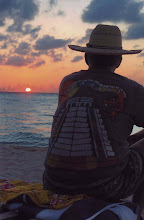Charles Miller’s father came to the United
States of America in the early 1800s from Scotland. In New York City, he met
and married his wife, who was from England. In 1849, the family of four -- including
Charlie's brother -- got gold fever and headed out to California. You may have
heard of the 49ers.
At Hat Creek in northern California, the
family was attacked by Indians and the father was killed. Unlike the kids of
today, Charlie got a job at the age of twelve, driving horses to Idaho. They
were involved in a running fight with more Indians. He worked with horses until
one bit him in the hand, going right through the muscle and bones.
He moved back to NYC. One night he attended
Buffalo Bill's Wild West Show at Madison Square Garden. It would change his
life. Charlie signed on and became Bronco Charlie. He was a bronco rider
and played in the Pony Express part of the show. I find it fascinating that
among the Indian employees were men who fought against Custer at Little Big
Horn.
Miller toured for thirty years with Buffalo
Bill, especially through Europe. Buffalo Bill has 680 people in his show, including three cooks, 38 servers, two barbers and 44 buffalo. The tour included England, Spain, Germany and
even a show in Naples, Italy. Today the countries that buy the most Indian
memorabilia are Germany and Italy.
In the 1930' he put on shows with his twenty
foot bull whip. One time he lit a wooden match with the bull whip while a Boy
Scout held it in his teeth. The Boy Scout then asked Charlie if he could shoot
a match out with a .22 while Charlie held it in his mouth. Charlie declined
saying he had lived so long by not being stupid, and that the Scout didn't look
like Annie Oakley to him.
He became friends with Sitting Bull and even
Teddy Roosevelt. At age 55 he fought in World War One with the Canadiens.
 |
| Sitting Bull |
His life ended back in New York City in a
nursing home in a wheel chair. He would receive up to 50 letters a day, all addressed
simply to Bronco Charlie. He only passed in 1955. Sometimes yjustcmtsup
Buffalo Bill's America is the fifth book I’ve
read about William Cody. The author teaches western American history at U.C.
Davis, where our friends Tom & Jeanette Egan and Steve & Sue George all
met for the very first time. William Cody was a very famous man.
"Where some wrote breathless summaries
of Miller’s true to life adventures, other less credulous observers marveled at
the art of his deception. It might even have been Miller’s wide New York press
coverage that inspired – appalled -- New York novelist Thomas Berger to conjure
a suspiciously similar, albeit fictional character, a man of almost-impossible
vintage named Jack Crabb. In two novels and one movie 1970 (starring Dustin
Hoffman ), protagonist Crabb, better known as Little Big Man, danced across
an imaginary stage as Cheyenne renegade, gunfighter, sole white
survivor of the Little Big Horn . . . and veteran of Buffalo Bill's Wild West
Show.”
The real Little Big Man was an Oglala Lakota,
a fearless warrior who fought with Crazy Horse. He was also at Little Big Horn
or the Fight at The Greasy Grass as the Indians called it.
 |
| Little Big Man |
See my blog “Como Se Llama.”
 |
| Standing Bear. He was 17 when he fought at Little Big Horn. |
The next time you are in Cody, or just
visiting Eastern Yellowstone Park, do yourself a favor and check out the
museum. Stay at Buffalo Bill's hotel, named after his daughter Irma. Saddle up
to the beautiful saloon bar and have a cold one. Don't forget to wear your
cowboy hat, and tell the bartender that TOCINO SENT YOU.
 |
| Buffalo Bill Cody |





No comments:
Post a Comment